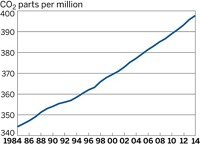Advertisement
Grab your lab coat. Let's get started
Welcome!
Welcome!
Create an account below to get 6 C&EN articles per month, receive newsletters and more - all free.
It seems this is your first time logging in online. Please enter the following information to continue.
As an ACS member you automatically get access to this site. All we need is few more details to create your reading experience.
Not you? Sign in with a different account.
Not you? Sign in with a different account.
ERROR 1
ERROR 1
ERROR 2
ERROR 2
ERROR 2
ERROR 2
ERROR 2
Password and Confirm password must match.
If you have an ACS member number, please enter it here so we can link this account to your membership. (optional)
ERROR 2
ACS values your privacy. By submitting your information, you are gaining access to C&EN and subscribing to our weekly newsletter. We use the information you provide to make your reading experience better, and we will never sell your data to third party members.
Environment
Ozone hole could heal in 40 years, experts say
Report points to lowered CFC-11 emissions from China
by Cheryl Hogue
January 10, 2023

The Earth’s protective stratospheric ozone layer is expected to rebound from depletion by commercial chemicals in the next 40 years, an international panel of scientists announced Jan. 9.
Chewed up by chlorofluorocarbons (CFCs) and other ozone-depleting compounds for decades, stratospheric ozone is on track for a return to 1980 levels in coming decades because of an international treaty, the panel says in a report. Atmospheric scientists use 1980 levels as a benchmark because it was before researchers from the British Antarctic Survey first observed the annual hole in the ozone layer in 1985.
If the world sticks to current chemical production policies under the Montreal Protocol on Substances that Deplete the Ozone Layer, stratospheric levels of ozone above Antarctica will recover by about 2066, the report says. Ozone concentrations over most of the rest of the world are expected to recover by 2040.
The report, issued by the World Meteorological Organization and the UN Environment Programme, finds that global emissions of CFC-11 began declining once again in 2018 after unexpectedly starting to rise in 2012. Most of this rise in CFC-11 emissions had come from eastern China, and that nation’s emissions have dropped significantly since 2018, it says.
However, evidence suggests significant recent emissions of CFC-11 from the Arabian peninsula and Indian subcontinent, the report adds.
The report also says that geoengineering efforts that would inject aerosols into the stratosphere to reflect sunlight into space and thus combat global warming could adversely affect ozone levels above Antarctica.




Join the conversation
Contact the reporter
Submit a Letter to the Editor for publication
Engage with us on Twitter